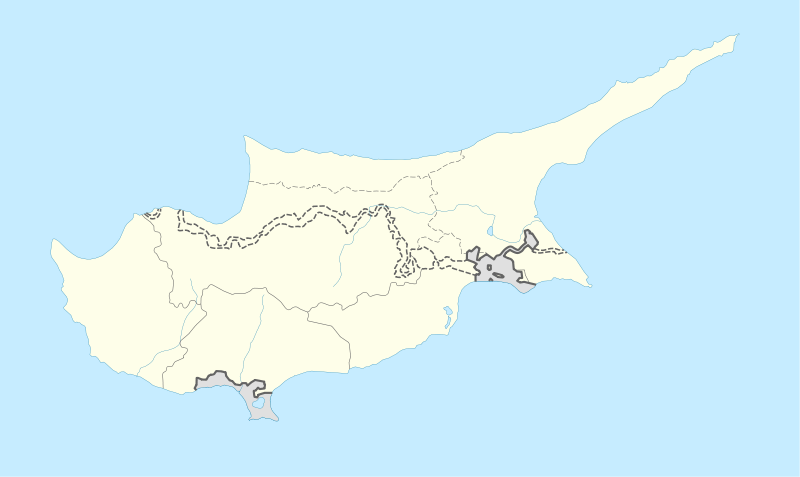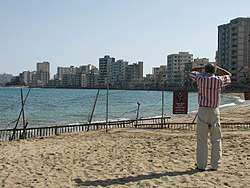Varosha, Famagusta
Varosha (Greek: Βαρώσια [locally [vaˈɾoʃa]]; Turkish: Maraş [maˈɾaʃ] or Kapalı Maraş[2][3]) is an abandoned southern quarter of the Cypriot city of Famagusta. Before 1974, it was the modern tourist area of the city. Its inhabitants fled during the Turkish invasion of Cyprus in 1974, when the city of Famagusta came under Turkish control, and it has remained abandoned ever since. As of 2019, the quarter continues to be uninhabited; buildings have decayed, and, in some cases, their contents have been looted over the years; some streets have been overgrown with vegetation; and the quarter is generally described as a ghost town. Entry is forbidden to the public.
Varosha | |
|---|---|
Varosha in 2006 | |
 Varosha | |
| Coordinates: 35°06′39″N 33°57′13″E | |
| Country (de jure) | |
| • District | Famagusta District |
| Country (de facto) | |
| • District | Gazimağusa District |
| Population (2011) | |
| • Total | 226 (Census of Northern Cyprus) |


History
In the early 1970s, Famagusta was the number-one tourist destination in Cyprus. To cater to the increasing number of tourists, many new high-rise buildings and hotels were constructed. During its heyday, Varosha was not only the number-one tourist destination in Cyprus, but between 1970 and 1974, it was one of the most popular tourist destinations in the world, and was a favourite destination of celebrities such as Elizabeth Taylor, Richard Burton, Raquel Welch, and Brigitte Bardot.
Features
The main features of Varosha included John F. Kennedy Avenue, a street which ran from close to the port of Famagusta, through Varosha and parallel to Glossa beach. Along JFK Avenue, there were many well known high rise hotels including the King George Hotel, The Asterias Hotel, The Grecian Hotel, The Florida Hotel, and The Argo Hotel which was the favourite hotel of Elizabeth Taylor. The Argo Hotel is located near the end of JFK Avenue, looking towards Protaras and Fig Tree Bay. Another major street in Varosha was Leonidas (Greek: Λεωνίδας), a major street that came off JFK Avenue and headed west towards Vienna Corner. Leonidas was a major shopping and leisure street in Varosha, consisting of bars, restaurants, nightclubs, and a Toyota car dealership.
1974 to present day
Before the Turkish invasion of Cyprus, the city of Varosha had a population of 39,000.[4] Following the invasion of Cyprus on July 20, 1974, the Greek Cypriot army withdrew its forces to Larnaca. The Turkish army advanced as far as the Green Line, which is the present day border between the two communities. Just hours before the Greek Cypriot and Turkish armies met in combat on the streets of Famagusta, the entire population fled, fearing a massacre. The evacuation was aided and orchestrated by the nearby British military base. Many refugees fled south to Paralimni, Dherynia, and Larnaca. Paralimni has since become the modern day capital of the Famagusta province.
When the Turkish Army gained control of the area during the invasion, they fenced it off and have since refused entry to anyone except Turkish military and United Nations personnel. The people living in Varosha hoped to return to their home when the situation calmed down, but the resort remained closed.
The UN Security Council Resolution 550 of 1984 ordered for Varosha to be handed over to the administration of the United Nations, and for it to be resettled by no other people than the inhabitants who were forced out. The Turkish state did not comply, and has held Varosha as a "bargaining chip" ever since[5] in the hope of persuading the people of Cyprus into accepting a settlement of the Cyprus issue on their terms.
One such settlement plan was the Annan Plan to reunify the island that provided for the return of Varosha to the original residents. But this was rejected by Greek Cypriots in a 2004 referendum. The UN Security Council Resolution 550 states that it "considers attempts to settle any part of Varosha by people other than its inhabitants as inadmissible and calls for the transfer of this area to the administration of the United Nations".[6]
The European Court of Human Rights awarded between €100,000 and €8,000,000 to eight Greek Cypriots for being deprived of their homes and properties as a result of the 1974 invasion. The case was filed jointly by businessman Constantinos Lordos and others, with the principal judgement in the Lordos case dating back to November 2010. The court ruled that, in the case of eight of the applicants, Turkey had violated Article 1 of Protocol 1 of the European Convention on Human Rights on the right of peaceful enjoyment of one's possessions, and in the case of seven of the applicants, Turkey had violated Article 8 on the right to respect for private and family life.
In the absence of human habitation and maintenance, buildings continue to decay. Over time, parts of the city have begun to be reclaimed by nature as metal corrodes, windows are broken, and plants work their roots into the walls and pavement and grow wild in old window boxes. In 2014, the BBC reported that sea turtles were observed nesting on the beaches in the city.[7]
During the Cyprus Missile Crisis (1997–1998), the Turkish Cypriot leader, Rauf Denktaş, threatened to take over Varosha if the Cypriot government did not back down.[8]
Court Cases
According to Greek Cypriots, 425 plots exists on the Varosha beach front, which extends from the Contandia hotel to the Golden Sands hotel. The complete number of plots in Varosha are 6082.[9]
There are 281 cases of Greek Cypriots who filed to the Immovable Property Commission (IPC) of Northern Cyprus for compensation.[10]
In 2020, Greek Cypriot Demetrios Hadjihambis opened a case against the state of Cyprus in Republic of Cyprus. He sought state compensation for financial losses.[11]
Reopening to inhabitation
Population of Varosha is 226 in 2011 Northern Cyprus census.[12]
In 2017, Varosha's beach was opened to be exclusively used by Turks (Turkish Cypriots and Turkish nationals).[13]
In 2019, the Government of Northern Cyprus announced it would open Varosha to settlement. On 14 November 2019, Ersin Tatar, the prime minister of Northern Cyprus, announced that Northern Cyprus aims to open Varosha by the end of 2020.[14]
On 25 July 2019, Varosha Inventory Commission of Northern Cyprus started its inventory analysis on the buildings and other infrastructure in Varosha.[15]
On 9 December 2019, Ibrahim Benter, the Director-General of the Turkish Cypriot EVKAF religious foundation's administration, said that all of Maraş/Varosha is the property of the EVKAF foundation. Benter said "EVKAF can sign renting contracts with Greek Cypriots if they accept that the fenced-off town belongs to the Evkaf."[16]
In 2019-20, inventory studies of buildings by the Government of Northern Cyprus was concluded.
On 15 February 2020, the Turkish Bar Association organised a round table meeting at the Sandy Beach Hotel in Varosha, which was attended by Turkish officials (Vice President Fuat Oktay and Justice Minister Abdulhamit Gül), Turkish Cypriot officials, representatives of the Turkish Cypriot religious foundation Evkaf, and Turkish and Turkish Cypriot lawyers.
In 22 February 2020, Cyprus declared it will veto European Union funds to Turkish Cypriots if Varosha opens to settlement.[17]
References
- In 1983, the Turkish Republic of Northern Cyprus unilaterally declared independence from the Republic of Cyprus. The de facto state is not recognised by any UN state except Turkey.
- Uğur Dağlı, Şehir Plancısı Naciye Doratlı, Şebnem Önal (1998). "Gazimağusa Şehrinin Kentsel Gelişiminin Sürdürülebilirliğine Yönelik Çözüm Önerileri" (in Turkish). Doğu Akdeniz Üniversitesi, Mimarlık Fakültesi. Retrieved 21 November 2012. Cite journal requires
|journal=(help)CS1 maint: uses authors parameter (link) - Doratlı, Naciye; İbrahim Numan; Özgür Dinçyürek (2002). "GAZİMAĞUSA'NIN FARKLI SENARYOLARA GÖRE DEĞİŞİMİNİN MORFOLOJİK AÇIDAN İRDELENMESİ" (in Turkish). DAÜ Mimarlık Fakültesi, KKTC. Retrieved 21 November 2012. Cite journal requires
|journal=(help) - Barnets, Nick (13 August 2014). "There Is a Ghost Town in Cyprus That's Been Held Hostage for 40 Years". VICE. Retrieved 15 January 2015.
- Abandoned Places by Kieron Connolly. London: Amber Books, 2016, pp. 110-111
- "United Nations Security Council Resolution 550" (PDF). United Nations. 11 May 1984. Retrieved 14 July 2012.
- Venema, Richard Hooper and Vibeke (2014-01-14). "The tourist resort abandoned in 1974". BBC News. Retrieved 2020-04-12.
- "Turkey hints at strike on Cypriot missiles". independent.
- "'Robust defence needed to block Turkey's unilateral plans for Varosha'". Cyprus Mail.
- "'Robust defence needed to block Turkey's unilateral plans for Varosha'". Cyprus Mail.
- "Court case seeking state compensation for refugees' financial losses after invasion starts". Cyprus Mail.
- "Northern Cyprus, State Planning Organization, The results of census of Northern Cyprus - 2011". Northern Cyprus, State Planning Organization. Retrieved 25 March 2020.
- "Turkish Army opens fenced-off Famagusta beach exclusively to Turkish nationals & Turkish-Cypriots!". Cyprus Tourism, 30.08.2017. Retrieved 25 March 2020.
- "Tatar says aim is to open Varosha by end of 2020". Cyprus Mail.
- "Inventory analyses have started in Varosha after 45 years". Hurriyet. Retrieved 25 March 2020.
- "Former Varosha Occupants Can Pay Rent: Benter". LGC news. Retrieved 25 March 2020.
- "Cyprus to veto EU funds to Turkish Cypriots if Varosha opens, Anastasiades says". Cyprus Mail.
External links
- BBC News - Varosha: The abandoned tourist resort
- Hopes for reunification NYTimes, 2015
- Nearly 50 Years On, a Forbidden Seaside Ghost Town is about to Re-Open
| Wikimedia Commons has media related to Varosha (Famagusta). |